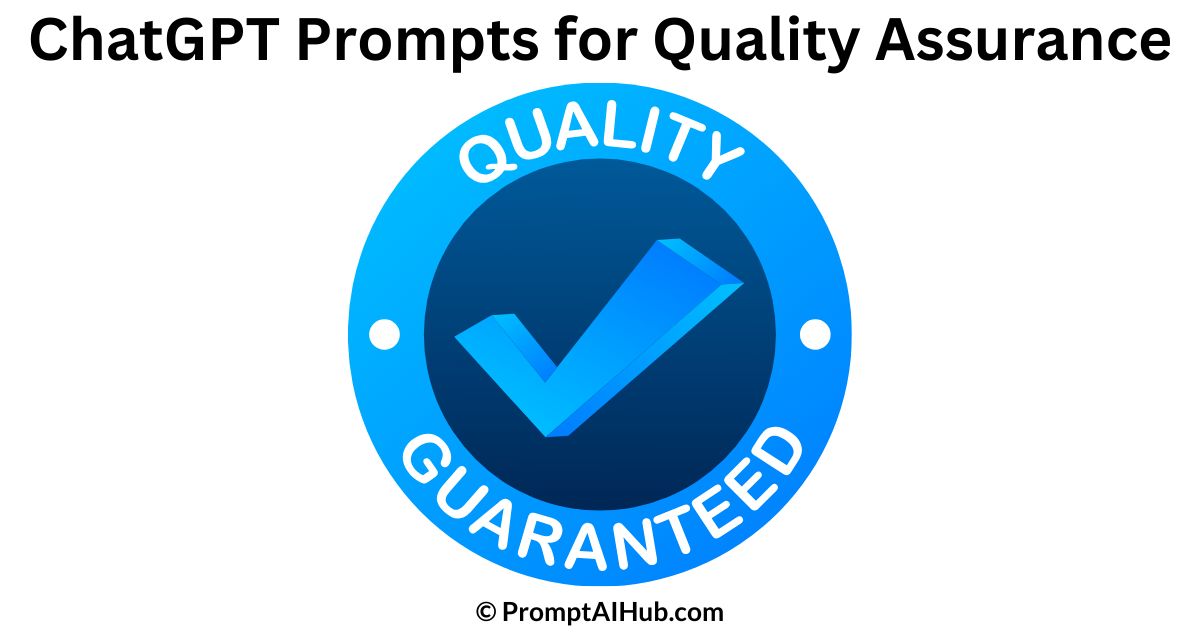Exploring the realm of Quality Assurance (QA) with ChatGPT? It’s not as complex as it may seem. In the next few minutes, you’ll discover 315 ChatGPT prompts tailored for QA that can revolutionize your approach to quality testing. Whether you’re a seasoned QA professional or just starting, reading this article thoroughly will equip you with valuable tools and strategies, enhancing your QA skills and efficiency. Let’s unravel the potential together.
Explore Our ChatGPT Prompts Library
ChatGPT Prompts for Quality Assurance (QA)
1. Define Objectives and Standards
1. Define Project Objectives:
Describe the key [project] objectives that need to be achieved. Include details about the project’s scope, purpose, and the desired outcomes. Specify how achieving these objectives contributes to overall [organizational] goals.
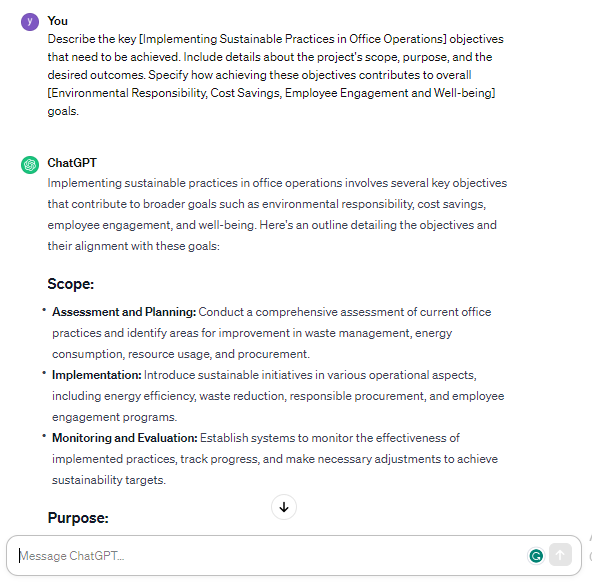
2. Establish Quality Standards:
Provide a detailed outline of the [product or service] quality standards. Specify the criteria for success, including measurable metrics and benchmarks. Clarify how these standards align with industry best practices and customer expectations.
3. Define QA Goals:
Outline the specific goals of the Quality Assurance (QA) process for [project or product]. Include information about the desired level of quality, any regulatory compliance requirements, and how QA contributes to overall [organizational] success.
4. Quantify Success Criteria:
Quantify the success criteria for [process or product] quality. Specify measurable indicators that determine the level of quality achieved. Include details about acceptable tolerances and thresholds for key performance indicators.
5. Align with Stakeholder Expectations:
Describe how the defined objectives and standards align with the expectations of [stakeholders], including customers, internal teams, and regulatory bodies. Highlight the process for gathering and incorporating stakeholder input.
6. Establish Performance Metrics:
Identify and detail the performance metrics that will be used to measure the effectiveness of the QA process. Specify which metrics are critical indicators of success and how they will be monitored throughout [project or product] development.
7. Incorporate Industry Best Practices:
Explain how the defined standards incorporate relevant industry best practices. Provide examples of specific practices or methodologies that will be applied to ensure [product or service] quality meets or exceeds industry norms.
8. Consider Regulatory Requirements:
Outline any regulatory requirements that must be adhered to in terms of [industry or product]. Explain how the QA objectives and standards address and comply with these regulations, ensuring a legally sound and compliant [product or service].
9. Define Scope and Boundaries:
Clearly define the scope and boundaries of the QA efforts. Specify what aspects of [project or product] are covered by QA and any areas that may be excluded. Provide a rationale for these decisions.
10. Map to Organizational Values:
Explain how the defined objectives and standards align with the core values and mission of the [organization]. Describe the broader impact of maintaining high-quality standards on the [organization’s] reputation and brand image.
Visit: 175 Useful ChatGPT Prompts For Quality Assurance (QA) Testing
11. Purpose and Scope Definition
Explain the critical importance of clearly defining the purpose and scope of a project or process in the context of quality assurance. Discuss the potential challenges and benefits associated with well-defined objectives.
12. Stakeholder Involvement
Detail the role of stakeholders in the definition of objectives and standards. Describe how involving key stakeholders contributes to a comprehensive understanding of project goals and quality expectations.
13. SMART Criteria Application
Explore the concept of SMART criteria (Specific, Measurable, Achievable, Relevant, Time-bound) in setting objectives and standards. Provide insights into how adhering to SMART principles enhances the clarity and effectiveness of quality goals.
14. Alignment with Business Goals
Discuss the importance of aligning quality objectives with broader business goals. Explain how a harmonized approach ensures that quality assurance efforts contribute directly to the organization’s success.
15. Regulatory and Compliance Considerations
Examine the role of regulatory requirements and compliance standards in shaping quality objectives. Discuss how adherence to industry-specific regulations influences the definition of quality standards.
16. Continuous Improvement Integration
Explore the concept of continuous improvement within the context of defining objectives and standards. Explain how building flexibility into quality goals accommodates evolving project needs.
17. Documentation Practices
Detail the significance of comprehensive documentation when defining objectives and standards. Discuss how well-documented quality criteria contribute to transparency, accountability, and effective communication within a team.
18. Risk Assessment and Mitigation
Explain the role of risk assessment in shaping quality objectives. Discuss how anticipating and addressing potential risks during the objective-setting phase contributes to proactive quality assurance.
19. Interdepartmental Collaboration
Discuss the benefits of fostering collaboration between different departments during the definition of objectives and standards. Provide examples of how cross-functional input enhances the overall quality assurance process.
20. Alignment with Customer Expectations
Explore the process of aligning quality objectives with customer expectations. Discuss strategies for gathering and incorporating customer feedback into the definition of standards to enhance overall satisfaction.
Visit: 133 Best ChatGPT Prompts For Generating Business Ideas
21. Define the Project’s Purpose and Scope
Explain the [project or product] objectives, its intended purpose, and the specific scope it is expected to cover. Include details on the desired outcomes and any overarching goals that will guide the project.
22. Establish Clear Quality Standards
Define the [industry-specific or project-specific] quality standards that need to be adhered to. Specify any regulatory requirements, industry benchmarks, or internal benchmarks that the team must consider when ensuring quality in the [product or process].
23. Outline Key Performance Indicators (KPIs)
Identify and describe the [quantifiable metrics] that will be used to measure the success and quality of the project. This may include metrics related to efficiency, accuracy, reliability, or any other relevant key performance indicators.
24. Set Quality Criteria for Deliverables
Provide detailed criteria for [specific deliverables or outcomes] that will be produced during the project. Clearly articulate the standards that these deliverables must meet, including any technical specifications, functional requirements, or performance expectations.
25. Define Stakeholder Expectations
Clarify the expectations of [key stakeholders, such as customers, clients, or regulatory bodies]. Detail the criteria that will be used to gauge stakeholder satisfaction and ensure that their needs and requirements are met throughout the project lifecycle.
26. Document Acceptance Criteria
Describe the [acceptance criteria] that will be used to determine whether a deliverable or phase of the project is acceptable and meets the predefined standards. Include both functional and non-functional aspects that need to be considered.
27. Address Compliance Requirements
Specify any [legal or regulatory requirements] that the project must adhere to. Include details on how compliance will be ensured throughout the project and how any changes in regulations will be monitored and integrated into the project plan.
28. Define Process Constraints and Limitations
Highlight any [limitations or constraints] that may impact the project’s ability to meet quality objectives. This could include resource constraints, time limitations, or technological limitations that need to be considered in the quality assurance process.
29. Establish Criteria for Risk Mitigation
Outline the criteria and strategies for [identifying and mitigating risks] that could impact the quality of the project. This includes potential risks related to technology, resources, external factors, or any other variables that may affect quality outcomes.
30. Develop a Comprehensive Quality Assurance Plan
Provide an overview of the [comprehensive quality assurance plan] that will guide the team in achieving the defined objectives and standards. Include details on the roles and responsibilities of team members, the processes for monitoring quality, and mechanisms for continuous improvement throughout the project.
Visit: 119 Unique ChatGPT Prompts For Letter Of Recommendation
2. Develop a Quality Management Plan
1. Outline QA Framework:
Describe the overarching Quality Assurance (QA) framework that will guide the development of the Quality Management Plan for [project or product]. Include information on the key principles, methodologies, and industry standards that will be incorporated.
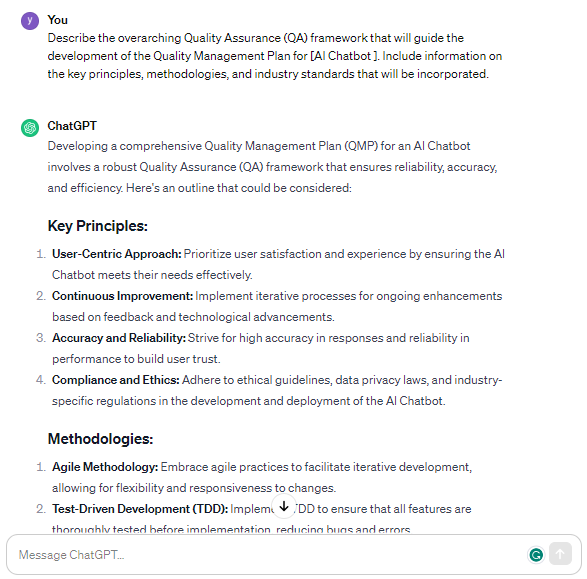
2. Identify Project Phases:
Outline the different phases of [project] development and explain how QA activities will be integrated into each phase. Specify the key deliverables and milestones that will trigger QA checkpoints.
3. Roles and Responsibilities:
Define the roles and responsibilities of individuals involved in QA activities. Specify who will be responsible for creating, executing, and overseeing the Quality Management Plan. Clarify how communication and collaboration will be facilitated among team members.
4. Resource Allocation:
Detail the resources, including personnel, tools, and technologies, that will be allocated to support QA activities. Provide information on how these resources will be managed and optimized throughout the [project] lifecycle.
5. Risk Management Strategy:
Develop a comprehensive risk management strategy within the Quality Management Plan. Identify potential risks to [project or product] quality, specify mitigation strategies, and outline contingency plans in case of unexpected issues.
6. Documentation Protocols:
Outline the protocols for documenting QA activities and results. Specify the types of documentation that will be created, including test plans, test cases, inspection reports, and any other relevant artifacts. Emphasize the importance of version control and traceability.
7. Communication Plan:
Develop a communication plan detailing how information about QA progress and issues will be shared with stakeholders. Specify the frequency and format of status updates, as well as the channels used for communication.
8. Integration with Development Process:
Explain how QA activities will be seamlessly integrated into the [project] development process. Describe the collaboration between QA and development teams, ensuring that QA is not a separate entity but an integral part of the overall workflow.
9. Training and Skill Development:
Develop a plan for training team members involved in QA activities. Identify the specific skills and knowledge required, and outline a training schedule that ensures team members are adequately prepared to fulfill their QA responsibilities.
10. Continuous Improvement Framework:
Establish a framework for continuous improvement within the Quality Management Plan. Describe how feedback from QA activities, customer input, and lessons learned will be systematically used to refine and enhance QA processes for future [projects or products].
Visit: 135 Powerful ChatGPT Prompts For Grammar Check
11. Scope and Objectives of the Quality Management Plan:
Describe the scope of the [project or process] that the Quality Management Plan will cover. Outline the specific objectives of the plan, detailing how it will contribute to the overall success of the [project or process].
12. Stakeholder Identification and Roles:
Identify the key stakeholders involved in [project or process]. Specify their roles and responsibilities in the Quality Management Plan. Explain how communication and collaboration with stakeholders will be managed.
13. Quality Assurance Team Structure:
Define the structure of the Quality Assurance (QA) team. Outline the roles and responsibilities of each team member. Include information about reporting lines, escalation procedures, and how team members will collaborate with other project teams.
14. Quality Processes and Methodologies:
Detail the specific quality processes and methodologies that will be employed in the [project or process]. Include information about testing strategies, inspection protocols, and any industry-recognized frameworks to be utilized.
15. Risk Management Strategies:
Outline the strategies for identifying, assessing, and mitigating risks related to quality in the [project or process]. Describe how the Quality Management Plan integrates with the overall risk management framework.
16. Documentation and Record-Keeping Procedures:
Specify the procedures for documenting and maintaining records related to quality. Outline the types of documents that will be generated, their purpose, and how version control will be managed.
17. Training and Skill Development Programs:
Describe the training programs and skill development initiatives for the QA team. Detail how team members will stay current with industry best practices and technologies. Include information about onboarding processes for new team members.
18. Tooling and Technology Infrastructure:
Identify the tools and technologies that will be used to support quality assurance efforts. Specify their roles in the QA process and how they integrate with other project tools and systems.
19. Audit and Compliance Procedures:
Define the procedures for conducting internal audits of the QA processes and ensuring compliance with established standards. Include details about how audit findings will be addressed and corrective actions implemented.
20. Continuous Improvement Mechanisms:
Outline the mechanisms for continuous improvement within the QA process. Describe how feedback from testing, inspections, and audits will be used to identify areas for improvement and how those improvements will be implemented in an iterative manner.
Visit: 245 Best ChatGPT Prompts For Goal Setting
21. Scope and Objectives of the Quality Management Plan:
In this section, describe the overarching scope and specific objectives of the Quality Management Plan (QMP) for [project or product]. Explain how the plan will contribute to achieving overall project goals and maintaining high-quality standards.
22. Identification of Key Stakeholders:
Provide a detailed list of key stakeholders involved in [project or product]. Explain how the Quality Management Plan will identify and engage with these stakeholders, considering their roles, interests, and expectations.
23. Roles and Responsibilities in the QMP:
Outline the roles and responsibilities of team members involved in implementing the Quality Management Plan. Specify who is responsible for quality assurance activities, document control, testing, and other relevant tasks throughout [project or product] development.
24. Quality Assurance Processes and Methodologies:
Detail the specific Quality Assurance processes and methodologies that will be employed in the QMP. Explain how these processes align with industry best practices and standards, and provide examples of how they will be implemented in [project or product].
25. Document Control Procedures:
Describe the procedures for document control within the Quality Management Plan. Specify how version control, document approval, and distribution will be managed to ensure that all team members have access to the latest and approved documentation.
26. Change Management Protocols:
Explain the protocols and procedures for managing changes to the [project or product]. Detail how changes will be assessed, approved, and implemented, considering their impact on quality and overall project objectives.
27. Quality Metrics and Key Performance Indicators (KPIs):
Identify and define the quality metrics and Key Performance Indicators (KPIs) that will be used to measure and monitor the effectiveness of the QMP. Explain how these metrics align with the overall quality objectives.
28. Training and Competency Development:
Outline the plans for training team members and ensuring their competency in executing quality assurance tasks. Specify the training programs, resources, and evaluation methods that will be used to enhance the skills of the team.
29. Communication and Reporting Protocols:
Detail the communication protocols for reporting on the status of quality within [project or product]. Specify the frequency and format of quality reports, as well as the channels through which information will be disseminated to relevant stakeholders.
30. Continuous Improvement Strategies:
Explain how the QMP will incorporate continuous improvement strategies. Describe the mechanisms for collecting feedback, conducting reviews, and implementing corrective actions to enhance the effectiveness of quality assurance processes over time.
Visit: 473 Best ChatGPT Prompts For Professionals
3. Understand Requirements
1. Customer Requirement Analysis:
Outline the systematic process for analyzing customer requirements for [product or service]. Specify the techniques and tools that will be employed to gather, document, and validate customer needs and expectations.
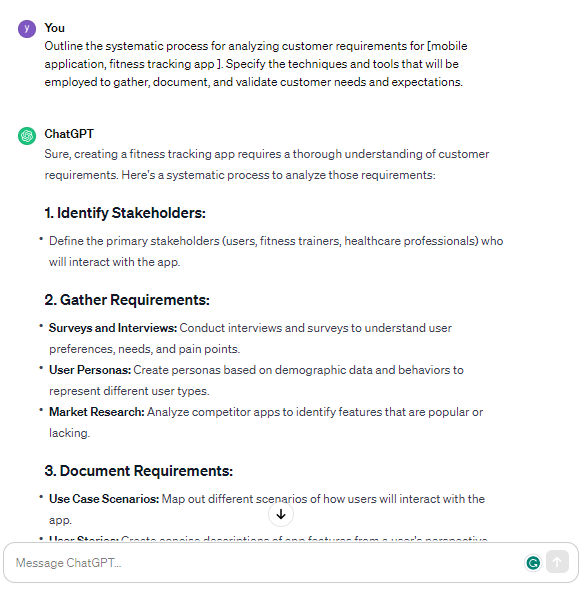
2. Stakeholder Collaboration:
Describe the approach for collaborating with various stakeholders to understand their unique requirements. Include details on how feedback from stakeholders, such as end-users, product owners, and subject matter experts, will be collected and incorporated.
3. Documenting Functional Requirements:
Explain the methods for documenting functional requirements. Specify the template or format to be used for creating a comprehensive functional requirements document, including information on features, functionalities, and performance criteria.
4. Non-functional Requirements Considerations:
Discuss the considerations for addressing non-functional requirements, such as performance, security, and usability. Detail how these requirements will be identified, documented, and tested throughout the [project] lifecycle.
5. Traceability Matrix Development:
Develop a plan for creating a traceability matrix that links requirements to test cases. Explain how this matrix will be used to ensure that all requirements are adequately covered by testing activities and how changes will be tracked.
6. Validation with End-Users:
Describe the strategy for validating requirements with end-users. Include information on how prototypes, user stories, or other validation techniques will be used to confirm that the [product or service] aligns with user expectations.
7. Change Control Process:
Establish a change control process for handling modifications to requirements during the [project] lifecycle. Explain how changes will be assessed, documented, communicated, and approved, ensuring that the QA process adapts accordingly.
8. Alignment with Business Goals:
Detail how the identified requirements align with broader [organizational] business goals. Explain the process for ensuring that QA efforts contribute directly to meeting these goals and maintaining overall business alignment.
9. Requirements Traceability to Test Cases:
Elaborate on how requirements will be traced to specific test cases. Detail the mapping process, ensuring that each requirement is covered by one or more test cases and that changes to requirements are reflected in the test plan.
10. Verification and Validation Criteria:
Define the criteria for verifying and validating requirements. Specify the methods and criteria that will be used to ensure that each requirement is correctly implemented and meets both functional and non-functional specifications.
Visit: 179 Awesome ChatGPT Prompts For Facebook Posts
4. Design and Implement Processes
1. Process Design Principles:
Articulate the fundamental principles that guide the design of [project or product] processes. Specify how these principles align with quality objectives, efficiency, and the overall goals of the [organization].
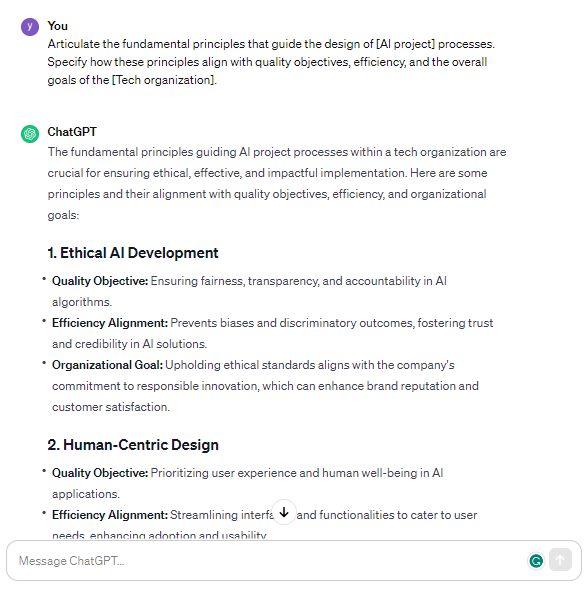
2. Process Mapping Techniques:
Describe the techniques and methodologies used for mapping out [project or product] processes. Explain how process flowcharts, diagrams, or other visual aids are employed to represent the sequence and interaction of various activities.
3. Integration with Development Lifecycle:
Detail the strategy for integrating QA processes seamlessly into the [project] development lifecycle. Specify how QA activities align with each phase, from requirements gathering to release, ensuring comprehensive quality coverage.
4. Defining Key Process Indicators:
Define the key process indicators that will be monitored to assess the effectiveness of QA processes. Specify how these indicators contribute to continuous improvement and how deviations from established benchmarks will be addressed.
5. Implementing Best Practices:
Outline the implementation of industry best practices within QA processes. Provide examples of specific practices or methodologies adopted to enhance efficiency, reduce defects, and improve overall [product or service] quality.
6. Quality Gate Checkpoints:
Explain the establishment of quality gate checkpoints throughout the [project or product] lifecycle. Detail the specific criteria and deliverables that must be met before progressing from one phase to the next, ensuring quality at every step.
7. Process Automation Strategies:
Discuss strategies for incorporating automation into QA processes. Specify which testing and validation activities can be automated, the tools and frameworks to be used, and the benefits of automation in terms of efficiency and repeatability.
8. Risk Mitigation in Processes:
Detail how QA processes address and mitigate potential risks in [project or product] development. Specify the identification, assessment, and mitigation strategies employed to minimize the impact of risks on quality outcomes.
9. Continuous Process Improvement:
Establish a framework for continuous improvement within QA processes. Describe how feedback from testing, inspections, and other QA activities is used to refine and enhance processes iteratively throughout the [project] lifecycle.
10. Roles in Process Implementation:
Define the roles and responsibilities of team members involved in implementing QA processes. Specify how collaboration is facilitated among different teams, including development, testing, and other relevant stakeholders, to ensure cohesive process implementation.
Visit: 145 Dynamic ChatGPT Prompts For Text Editing
5. Training and Skill Development
1. Identification of Training Needs:
Develop a strategy for identifying the training needs of the QA team and relevant stakeholders. Specify the criteria for assessing current skill levels, gaps in knowledge, and emerging trends in [industry or technology] that necessitate training.
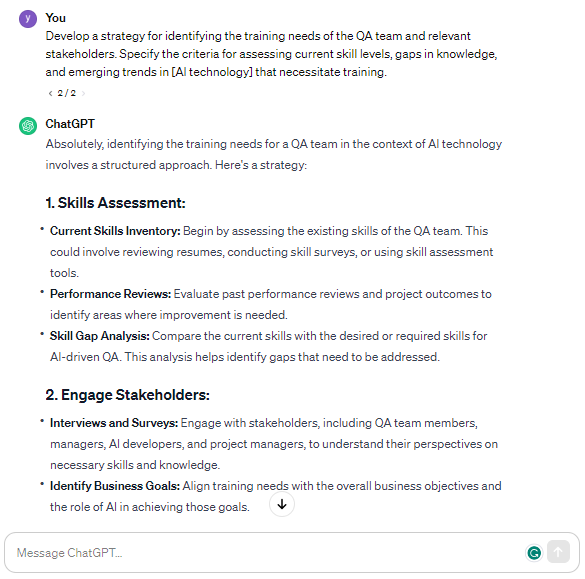
2. Customized Training Programs:
Outline the design and implementation of customized training programs for the QA team. Specify how these programs cater to the specific needs identified, incorporating hands-on exercises, workshops, and real-world scenarios for practical skill development.
3. Technical Skill Enhancement:
Detail the technical skills essential for QA professionals and how these skills will be enhanced through training. Include areas such as test automation, performance testing, and proficiency in relevant tools or technologies.
4. Soft Skills Development:
Discuss the importance of soft skills in QA roles and the strategies for developing them. Specify how communication, collaboration, problem-solving, and critical thinking skills will be fostered to enhance overall team effectiveness.
5. Certification Programs:
Explore the potential integration of industry-recognized certification programs into the QA training curriculum. Specify which certifications are relevant to [project or product] requirements and how achieving these certifications adds value to the QA team.
6. Continuous Learning Culture:
Establish a culture of continuous learning within the QA team. Detail how resources such as online courses, webinars, and conferences will be leveraged to keep the team updated on the latest developments in QA methodologies and technologies.
7. Cross-Functional Training:
Describe the approach for cross-functional training to enhance collaboration between QA and other teams, such as development and product management. Specify the topics and activities that will facilitate a better understanding of each team’s roles and responsibilities.
8. Mentorship Programs:
Implement mentorship programs within the QA team to facilitate knowledge transfer and skill development. Specify how experienced team members will mentor junior members, sharing insights, best practices, and practical experiences.
9. Feedback and Evaluation Mechanisms:
Establish mechanisms for gathering feedback on training programs and evaluating the effectiveness of skill development initiatives. Specify how feedback from participants and key performance indicators will be used to refine and improve future training sessions.
10. Adaptation to Emerging Technologies:
Address how the QA team will adapt to emerging technologies and methodologies. Specify the mechanisms in place for monitoring industry trends, evaluating their relevance to [project or product] QA, and incorporating new skills into the training program to stay ahead in the field.
Visit: The 79 Best ChatGPT Chrome Extensions (Tried And Tested)
11. Role-Specific Training Paths:
Design role-specific training paths within the QA team. Specify how training programs will be tailored for different roles, such as test engineers, automation specialists, and QA leads, ensuring targeted skill development aligned with responsibilities.
12. Industry Compliance Training:
Outline the plan for providing training on industry-specific compliance and regulatory requirements. Specify the standards applicable to [project or product], and detail how the QA team will stay informed and trained to meet these compliance standards.
13. Performance Metrics Training:
Educate the QA team on the use and interpretation of performance metrics. Specify how team members will be trained to analyze key performance indicators, identify trends, and use data-driven insights to improve QA processes continually.
14. Agile and DevOps Practices:
Incorporate training on Agile methodologies and DevOps practices into the QA curriculum. Specify how QA professionals will be trained to seamlessly integrate QA activities into Agile sprints and collaborate effectively within DevOps environments.
15. Cybersecurity Awareness:
Address the importance of cybersecurity awareness in QA roles. Specify the cybersecurity principles that QA professionals need to understand, and detail how training programs will enhance their ability to identify and mitigate security risks.
16. Effective Test Case Design:
Develop training modules focused on effective test case design. Specify the criteria for creating comprehensive and efficient test cases, including considerations for different testing levels, test coverage, and the traceability of test cases to requirements.
17. Collaborative Tool Training:
Describe the training plan for collaborative tools used in QA processes, such as version control systems, test management tools, and communication platforms. Specify how proficiency in these tools will be developed to streamline QA activities.
18. Incorporating User Experience (UX) Testing:
Explore the integration of training on User Experience (UX) testing principles. Specify how QA professionals will be trained to evaluate the user interface, identify usability issues, and ensure a positive overall user experience.
19. Crisis Response Training:
Address crisis response training within the QA team. Specify how team members will be trained to handle unexpected issues, such as critical defects or production incidents, ensuring a rapid and effective response to minimize impact.
20. Feedback-Driven Skill Development:
Implement a feedback-driven approach to skill development. Specify how feedback from performance reviews, project retrospectives, and peer assessments will be used to create personalized skill development plans for each member of the QA team.
Visit: 99 Helpful ChatGPT Prompts For Day Trading
21. Cross-Team Collaboration Workshops:
Organize workshops focused on cross-team collaboration. Specify how these workshops will bring together QA, development, and other relevant teams to enhance communication, foster teamwork, and align processes for improved overall efficiency.
22. Regression Testing Strategies Training:
Provide training on regression testing strategies. Specify the techniques and approaches for efficiently conducting regression testing, ensuring that changes to the [product or system] do not adversely impact existing functionalities.
23. Accessibility Testing Awareness:
Integrate training on accessibility testing principles. Specify how QA professionals will be trained to evaluate [product or service] accessibility, identify potential barriers, and ensure compliance with accessibility standards and guidelines.
24. Test Data Management:
Develop a training program on effective test data management. Specify how QA professionals will be trained to create, manage, and use test data to simulate real-world scenarios, ensuring thorough testing coverage.
25. Emerging Testing Technologies:
Address training on emerging testing technologies. Specify how the QA team will stay updated on advancements in areas such as artificial intelligence in testing, blockchain testing, and other innovative testing methodologies.
26. Remote Collaboration Skills:
Recognize the importance of remote collaboration skills in QA roles. Specify how training programs will address the challenges of remote work, emphasizing effective communication, time management, and collaboration in virtual environments.
27. Security Testing Best Practices:
Provide training on security testing best practices. Specify how QA professionals will be trained to identify and address security vulnerabilities, conduct threat modeling, and contribute to a robust security posture for [product or system].
28. Knowledge Transfer Mechanisms:
Establish mechanisms for effective knowledge transfer within the QA team. Specify how experienced team members will share their expertise with new members, fostering a culture of continuous learning and skill development.
29. Behavior-Driven Development (BDD) Training:
Incorporate training on Behavior-Driven Development (BDD) principles and practices. Specify how QA professionals will be trained to collaborate with stakeholders using Gherkin syntax and tools like Cucumber to bridge the gap between business requirements and test scenarios.
30. Ethical Testing Practices:
Address ethical testing practices within the training curriculum. Specify how QA professionals will be trained to consider ethical implications, privacy concerns, and legal considerations when conducting testing activities, ensuring responsible and transparent QA practices.
Visit: 37 Best Free Chrome Extensions For Google Bard (Tried & Tested)
6. Document Control
1. Document Control Framework:
Establish a document control framework for [project or product] QA. Specify the procedures, tools, and systems that will be used to manage and control documents throughout their lifecycle, ensuring version control and accessibility.
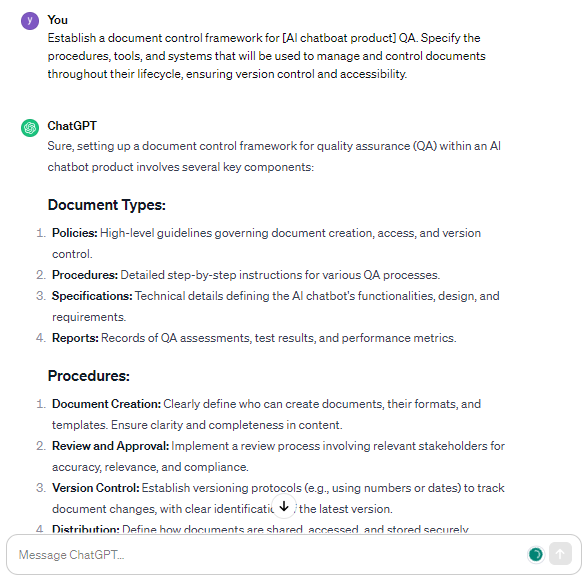
2. Document Identification and Naming Conventions:
Define the identification and naming conventions for [project or product] documents. Specify how documents will be uniquely identified, named, and organized to facilitate easy retrieval and prevent confusion within the QA team.
3. Versioning Protocols:
Outline the versioning protocols within the document control system. Specify how version numbers or labels will be assigned, updated, and tracked, ensuring that team members are working with the latest and approved versions of documents.
4. Access Controls and Permissions:
Detail the access controls and permissions for [project or product] documents. Specify who has access to different types of documents, and define the levels of permissions for viewing, editing, and approving, ensuring data security and confidentiality.
5. Change Request Procedures:
Develop procedures for handling change requests to documents. Specify how change requests will be submitted, reviewed, approved, and implemented, ensuring that modifications are well-documented and traceable.
6. Document Review and Approval Workflow:
Describe the workflow for document review and approval. Specify the roles and responsibilities of individuals involved in the review and approval process, and detail how feedback will be incorporated before final approval.
7. Audit Trail Mechanisms:
Implement mechanisms for maintaining an audit trail of document activities. Specify how the system will log changes, access, and modifications to documents, providing transparency and accountability for all document-related actions.
8. Integration with Collaboration Tools:
Discuss the integration of document control with collaboration tools. Specify how documents stored in collaboration platforms or version control systems will be synchronized, ensuring consistency and avoiding conflicts.
9. Retirement and Archiving Procedures:
Develop procedures for retiring and archiving documents. Specify the criteria for identifying documents that are no longer relevant, and detail how these documents will be archived, ensuring compliance with retention policies.
10. Training on Document Control Procedures:
Provide training on document control procedures for the QA team. Specify how team members will be trained on using the document control system, understanding versioning, and adhering to established protocols, ensuring uniformity in document management practices.
Visit: 7 Best Free Chrome Extensions For Bing AI Chat (Tried & Tested)
7. Quality Inspections and Audits
1. Quality Inspection Framework:
Develop a comprehensive framework for conducting quality inspections in [project or product] QA. Specify the criteria, checklists, and methodologies that will be used to systematically inspect deliverables and processes, ensuring adherence to quality standards.
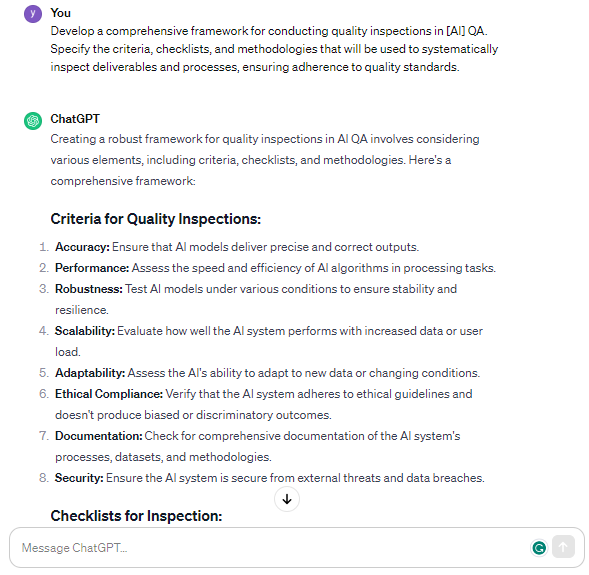
2. Audit Planning and Scheduling:
Outline the process for planning and scheduling quality audits. Specify how audit schedules will be established, the criteria for selecting audit participants, and the frequency of audits throughout the [project or product] lifecycle.
3. Audit Scope Definition:
Define the scope of quality audits for [project or product]. Specify the boundaries and focus areas of audits, including processes, documentation, and deliverables, ensuring a thorough and targeted examination of QA-related aspects.
4. Auditor Training and Competency:
Detail the training and competency requirements for auditors. Specify the skills, knowledge, and certifications that auditors should possess, and describe the ongoing training programs to keep auditors updated on industry best practices.
5. Checklist Development for Inspections:
Develop detailed checklists for quality inspections. Specify the criteria, benchmarks, and key performance indicators that will be included in inspection checklists, ensuring a standardized and comprehensive approach to evaluations.
6. Process for Non-Conformity Reporting:
Outline the process for reporting and managing non-conformities identified during inspections and audits. Specify how non-conformities will be documented, escalated, and addressed to prevent recurrence and improve overall quality.
7. Cross-Functional Audit Teams:
Discuss the composition and collaboration of cross-functional audit teams. Specify how members from different departments or teams will collaborate during audits to provide diverse perspectives and insights into QA processes.
8. Root Cause Analysis in Audits:
Describe the methodology for conducting root cause analysis during audits. Specify how auditors will investigate the underlying causes of identified issues, and detail the corrective actions and preventive measures that will be recommended.
9. Continuous Improvement Feedback Loop:
Establish a feedback loop for continuous improvement based on audit findings. Specify how feedback from audits will be analyzed, and detail the mechanisms for incorporating lessons learned into future QA processes and practices.
10. Integration of Automated Tools in Audits:
Explore the integration of automated tools in quality audits. Specify how testing tools and technologies will be used to enhance the efficiency and accuracy of audits, ensuring a more comprehensive and data-driven assessment.
Visit: 141 Tested Google Bard Prompts For Marketing
11. Documentation Verification Procedures:
Develop procedures for verifying the completeness and accuracy of project documentation during inspections and audits. Specify how auditors will ensure that documentation aligns with established standards, requirements, and traceability criteria.
12. Risk-Based Audit Planning:
Implement a risk-based approach to audit planning. Specify how the level of scrutiny during audits will be determined based on identified risks, potential impact, and criticality to the success of the [project or product].
13. Supplier and Vendor Audits:
Address the process for conducting supplier and vendor audits. Specify the criteria for selecting suppliers or vendors for audits, and detail how these audits will ensure that external partners meet quality and compliance standards.
14. Audit Reporting and Communication:
Outline the format and content of audit reports. Specify how findings, recommendations, and identified non-conformities will be documented and communicated to relevant stakeholders, ensuring clarity and transparency.
15. Scalability of Audit Processes:
Discuss the scalability of audit processes for different project scales. Specify how audit processes will be adapted to accommodate the size and complexity of projects, ensuring a balanced and effective approach for varying scopes.
16. Benchmarking against Industry Standards:
Incorporate benchmarking against industry standards in audit processes. Specify how auditors will compare QA practices and outcomes against relevant industry benchmarks, ensuring continuous alignment with best practices.
17. Audit Closure and Follow-Up:
Detail the closure procedures for audits and the subsequent follow-up actions. Specify how audit closure reports will be generated, and detail the mechanisms for tracking and validating the implementation of corrective and preventive actions.
18. Data Privacy and Compliance Audits:
Address the specifics of conducting data privacy and compliance audits. Specify how auditors will ensure that QA processes align with data protection regulations and other relevant compliance requirements.
19. Auditing Agile and DevOps Practices:
Explore the nuances of auditing Agile and DevOps practices. Specify how auditors will assess the effectiveness of QA processes within an Agile framework, ensuring that iterative and continuous delivery models are appropriately validated.
20. Customer Satisfaction Audits:
Integrate customer satisfaction audits into the QA framework. Specify how customer feedback and satisfaction levels will be audited, and detail the mechanisms for incorporating customer input into QA improvements and initiatives.
Visit: 31 Effective Google Bard Prompts For Resume Writing
21. Audit Training Programs:
Establish training programs for teams undergoing audits. Specify how teams will be educated on the audit process, their roles during audits, and the expectations for collaboration, ensuring a standardized and informed approach to audit participation.
22. Usability Inspection Guidelines:
Develop guidelines for inspecting the usability of [product or system] features. Specify the criteria and usability principles that auditors will evaluate, and detail how user experience considerations will be integrated into the inspection process.
23. Integration of Statistical Sampling:
Explore the integration of statistical sampling techniques in audits. Specify how statistical methods will be used to select representative samples for inspection, providing a quantitative basis for assessing the overall quality of the [product or system].
24. Knowledge Transfer Audits:
Address the process for conducting knowledge transfer audits within the team. Specify how audits will assess the effectiveness of knowledge transfer mechanisms, ensuring that information is shared effectively across team members.
25. Documentation Accessibility Audits:
Detail procedures for conducting audits on the accessibility of project documentation. Specify how auditors will assess the readability, clarity, and inclusivity of documentation, ensuring that information is accessible to all team members.
26. Audit Trail Review:
Implement a review process for audit trails generated during inspections. Specify how audit trails will be periodically reviewed to ensure accuracy, completeness, and compliance with data retention policies and security protocols.
27. Early-Phase Inspections:
Discuss the benefits and methodologies for conducting inspections during early project phases. Specify how inspections in the planning and design phases contribute to proactive issue identification and prevention.
28. Crisis Preparedness Audits:
Develop audit procedures focused on assessing crisis preparedness. Specify how audits will evaluate the effectiveness of crisis response plans, ensuring the team is adequately equipped to handle unexpected challenges.
29. Effectiveness of Training Audits:
Address the audit of training effectiveness within the QA team. Specify how audits will assess the retention and application of knowledge acquired through training programs, contributing to ongoing skill development.
30. Audit Performance Metrics:
Define key performance metrics for evaluating the effectiveness of the audit process. Specify how metrics such as audit completion time, findings closure time, and overall audit impact will be measured and analyzed for continuous improvement.
Visit: 221 Unique Bard Prompts for Character Ideas
8. Testing and Validation
1. Test Strategy Development:
Develop a comprehensive strategy for testing [project or product]. Specify the testing objectives, scope, and levels (unit, integration, system, etc.), and describe how the testing strategy aligns with the overall QA goals and project requirements.
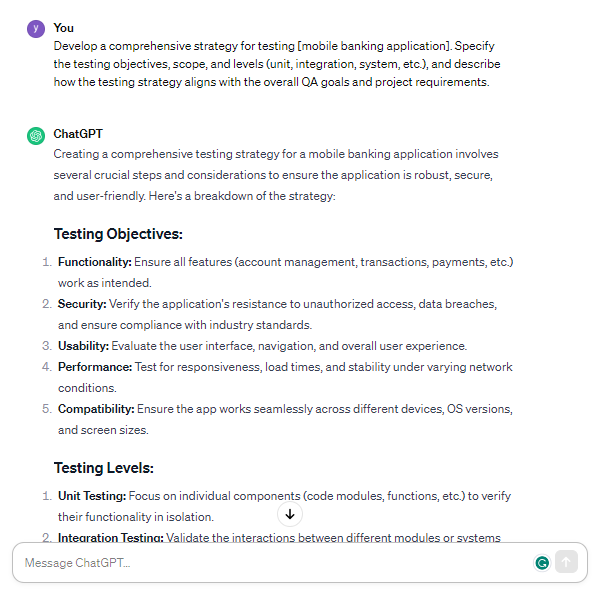
2. Test Case Design Principles:
Outline the principles for designing effective test cases for [project or product]. Specify how test cases will be derived from requirements, the use of positive and negative scenarios, and the criteria for ensuring comprehensive test coverage.
3. Automation Feasibility Assessment:
Conduct an assessment of automation feasibility for [project or product] testing. Specify the criteria for identifying test cases suitable for automation, the selection of appropriate automation tools, and the expected benefits of test automation.
4. Performance Testing Approach:
Define the approach for performance testing in [project or product]. Specify the performance metrics to be measured, the types of performance tests to be conducted (load, stress, scalability, etc.), and the criteria for determining acceptable performance levels.
5. Validation of Business Rules:
Detail the process for validating business rules in [project or product]. Specify how business rules will be identified, translated into test scenarios, and systematically validated to ensure alignment with project objectives and stakeholder expectations.
6. User Acceptance Testing (UAT) Procedures:
Develop procedures for conducting User Acceptance Testing (UAT). Specify how UAT will be planned, executed, and documented, including the involvement of end-users, criteria for acceptance, and the resolution of identified issues.
7. Security Testing Protocols:
Implement protocols for conducting security testing on [project or product]. Specify how security vulnerabilities will be identified, the tools and methodologies used for testing, and the measures taken to address and mitigate security risks.
8. Regression Testing Best Practices:
Define best practices for regression testing in [project or product]. Specify how regression test suites will be maintained, the criteria for selecting test cases, and the frequency of regression testing to ensure ongoing software stability.
9. Usability Validation Criteria:
Establish criteria for validating the usability of [product or system] features. Specify how usability tests will be designed, the involvement of end-users in usability validation, and the criteria for determining a positive user experience.
10. Cross-Browser and Cross-Platform Testing:
Outline the strategy for cross-browser and cross-platform testing. Specify the browsers and platforms to be covered, the tools for testing compatibility, and the criteria for ensuring a consistent user experience across different environments.
Visit: 101 Best Bard Prompts For Cold Email Marketing
11. Mobile Testing Strategies:
Develop a training program focused on mobile testing strategies. Specify how QA professionals will be trained to address challenges specific to mobile platforms, including diverse devices, operating systems, and network conditions.
12. Cloud-Based Testing Environments:
Integrate training on utilizing cloud-based testing environments. Specify how QA professionals will be trained to leverage cloud services for scalable and flexible testing infrastructure, ensuring adaptability to varying workloads.
13. Exploratory Testing Techniques:
Provide training on exploratory testing techniques. Specify how QA professionals will be trained to conduct structured exploratory testing, encouraging creativity and adaptability to identify defects that may not be captured by scripted tests.
14. Globalization and Localization Testing:
Address training on globalization and localization testing. Specify how QA professionals will be trained to ensure [product or service] compatibility with diverse cultures and languages, considering factors such as date formats, currencies, and regional preferences.
15. Continuous Integration/Continuous Deployment (CI/CD) Awareness:
Integrate training on CI/CD principles and practices. Specify how QA professionals will be trained to collaborate with development teams to seamlessly integrate testing into CI/CD pipelines, promoting faster and more reliable releases.
16. Usability Testing Techniques:
Develop a training program on usability testing techniques. Specify how QA professionals will be trained to assess the [product or service] from the user’s perspective, ensuring a positive and intuitive user experience.
17. Data Privacy Compliance Training:
Address the importance of data privacy compliance in QA roles. Specify how training programs will cover relevant regulations, such as GDPR, and how QA professionals will be trained to ensure the secure handling of user data.
18. Integration Testing Strategies:
Provide training on integration testing strategies. Specify how QA professionals will be trained to validate the interaction between different components or systems, ensuring seamless functionality across interconnected parts of the [product or system].
19. Root Cause Analysis Techniques:
Develop a training program on root cause analysis techniques. Specify how QA professionals will be trained to investigate and identify the underlying causes of defects, contributing to effective issue resolution and prevention.
20. Performance Engineering Principles:
Integrate training on performance engineering principles. Specify how QA professionals will be trained to proactively address performance issues throughout the development lifecycle, emphasizing load testing, scalability, and optimization strategies.
Visit: 71 Unique Google Bard Prompts for Social Media Ads
9. Feedback and Continuous Improvement
1. Establishing Feedback Mechanisms:
Develop a framework for establishing robust feedback mechanisms within [project or product] QA. Specify how feedback from team members, stakeholders, and end-users will be systematically gathered, and describe the channels and tools used for effective feedback collection.
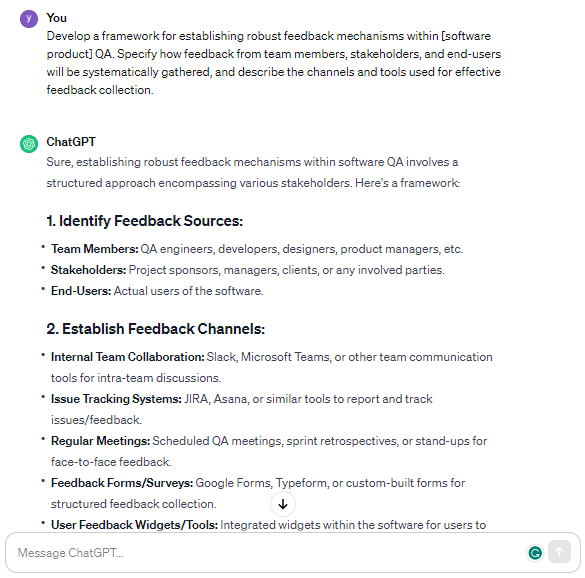
2. Feedback Analysis and Categorization:
Outline the process for analyzing and categorizing feedback received in [project or product] QA. Specify how feedback will be categorized based on its nature, urgency, and impact on quality, and describe the criteria for prioritizing feedback for action.
3. Continuous Improvement Culture:
Establish a culture of continuous improvement within the QA team. Specify how the team will embrace a mindset of learning from feedback, adapting processes, and fostering an environment where team members actively contribute to ongoing improvements.
4. Root Cause Analysis for Issues:
Define the methodology for conducting root cause analysis on identified issues. Specify how issues, defects, or challenges will be systematically investigated to identify underlying causes, and describe the process for implementing corrective and preventive actions.
5. Metrics-Driven Improvement:
Develop a metrics-driven approach to continuous improvement in [project or product] QA. Specify the key performance indicators (KPIs) that will be monitored, and describe how metrics will guide decision-making and contribute to the overall improvement strategy.
6. Learning from Defects:
Outline strategies for learning from defects and issues identified during testing. Specify how post-mortem analyses will be conducted, and describe how the insights gained from defects will inform future testing approaches and preventive measures.
7. Incident Response Improvement Plans:
Develop improvement plans for incident response based on feedback and lessons learned. Specify how incident response processes will be refined, and describe the mechanisms for enhancing the team’s preparedness to handle unforeseen challenges.
8. User Feedback Integration:
Detail how user feedback will be integrated into the continuous improvement process. Specify the channels through which user feedback will be collected, and describe how this feedback will be analyzed and used to enhance [product or system] quality.
9. Implementing Best Practices:
Incorporate industry best practices into the continuous improvement initiatives. Specify examples of proven practices or methodologies that will be adopted, and describe how these best practices will be implemented to elevate the overall QA process.
10. Feedback Loop Closure:
Establish procedures for closing the feedback loop within [project or product] QA. Specify how feedback, once addressed and incorporated, will be communicated back to the relevant stakeholders, and describe the mechanisms for ensuring closure on feedback-related actions.
Visit: 57 Proven Google Bard Prompts for Google Ads Fuel Your Advertising Success
11. Team Collaboration for Improvement:
Define collaborative approaches for involving the entire QA team in the continuous improvement process. Specify how team members will be encouraged to share insights, contribute suggestions, and actively participate in discussions to enhance QA practices.
12. Customer Satisfaction Surveys:
Integrate customer satisfaction surveys into the feedback and improvement process. Specify how surveys will be designed, distributed, and analyzed to capture the customer perspective on the quality of [product or service], guiding improvement efforts accordingly.
13. Technology Adoption Feedback:
Develop a mechanism for gathering feedback on the adoption of new testing technologies or tools. Specify how team members’ experiences with these technologies will be assessed, and describe the process for optimizing their integration into QA workflows.
14. Training Program Evaluations:
Establish evaluation processes for assessing the effectiveness of training programs within the QA team. Specify how feedback from training sessions will be collected and analyzed, and describe how training content and delivery methods will be refined.
15. Cross-Team Collaboration Enhancement:
Define strategies for enhancing cross-team collaboration through feedback. Specify how feedback mechanisms will be used to improve communication and collaboration between QA and other teams, contributing to a more integrated development process.
16. Incorporating Lessons Learned:
Outline procedures for incorporating lessons learned from past projects into ongoing QA practices. Specify how retrospectives and post-mortem analyses will be conducted, and describe how insights gained will be documented and shared for continuous improvement.
17. Innovation and Experimentation Feedback:
Encourage innovation and experimentation within the QA team, and define feedback mechanisms for assessing the success and impact of new approaches. Specify how lessons from both successful and unsuccessful experiments will inform future initiatives.
18. Leadership Involvement in Improvement:
Discuss the role of leadership in driving continuous improvement. Specify how leadership will actively support and participate in improvement initiatives, providing guidance, resources, and reinforcement for the importance of ongoing quality enhancement.
19. Flexible Process Adaptations:
Establish a framework for adapting QA processes flexibly based on feedback. Specify how processes will be reviewed regularly, and describe the criteria and considerations for making adjustments to accommodate evolving project requirements and industry trends.
20. Celebrating Success and Milestones:
Define ways to celebrate and acknowledge successful improvements and milestones within the QA team. Specify how achievements, both big and small, will be recognized, fostering a positive and motivated environment for continuous improvement efforts.
Visit: 109 Useful Google Bard Prompts For Entrepreneurs
21. Knowledge Sharing Forums:
Implement knowledge-sharing forums for the QA team. Specify how regular forums, such as brown bag sessions, will be organized to encourage knowledge exchange, discuss challenges, and share insights, contributing to collective learning.
22. Feedback from External Reviews:
Outline the process for collecting and incorporating feedback from external reviews or audits. Specify how external assessments will be leveraged to identify areas for improvement and validate the effectiveness of QA processes.
23. Balancing Speed and Quality Feedback:
Address the balance between speed and quality in QA processes. Specify how feedback will be gathered on the trade-offs between rapid development cycles and maintaining high-quality standards, and describe strategies for optimizing this balance.
24. Continuous Monitoring of Process Metrics:
Establish a system for the continuous monitoring of key process metrics. Specify how metrics related to defect rates, testing efficiency, and other relevant KPIs will be monitored in real-time, enabling timely interventions for improvement.
25. Agile Retrospectives:
Implement Agile retrospectives within the QA team. Specify how retrospective sessions will be conducted at the end of each iteration, focusing on identifying opportunities for improvement and fostering a culture of continuous reflection and adaptation.
26. Adapting to Industry Trends:
Detail the approach for adapting QA practices to align with emerging industry trends. Specify how the team will stay informed about evolving best practices, tools, and methodologies, and describe mechanisms for integrating these trends into QA processes.
27. Cultural Feedback Integration:
Integrate feedback related to organizational culture into continuous improvement efforts. Specify how aspects such as teamwork, communication, and employee well-being will be assessed and addressed to create a positive and conducive working environment.
28. Gamification of Improvement Initiatives:
Explore the gamification of improvement initiatives within the QA team. Specify how gamified elements, such as challenges, rewards, and recognition, will be incorporated to make the continuous improvement process engaging and motivating for team members.
29. Regular Process Audits:
Implement regular process audits to assess adherence to QA processes. Specify how these audits will be conducted, the criteria for evaluating process compliance, and the actions taken based on audit findings to reinforce process discipline.
30. Incorporating Diversity of Perspectives:
Emphasize the importance of incorporating a diversity of perspectives in feedback. Specify how input from team members with varied roles, experiences, and backgrounds will be sought and valued in the continuous improvement process, promoting inclusivity.
Visit: 81 Well-Structured Google Bard Prompts For Generate Sales Strategy
10. Metrics and Measurement
1. Defining Key Performance Indicators (KPIs):
Develop a set of key performance indicators (KPIs) for [project or product] QA. Specify the metrics that will be used to assess the effectiveness of QA processes, including defect density, test coverage, and release stability, aligning with project goals.
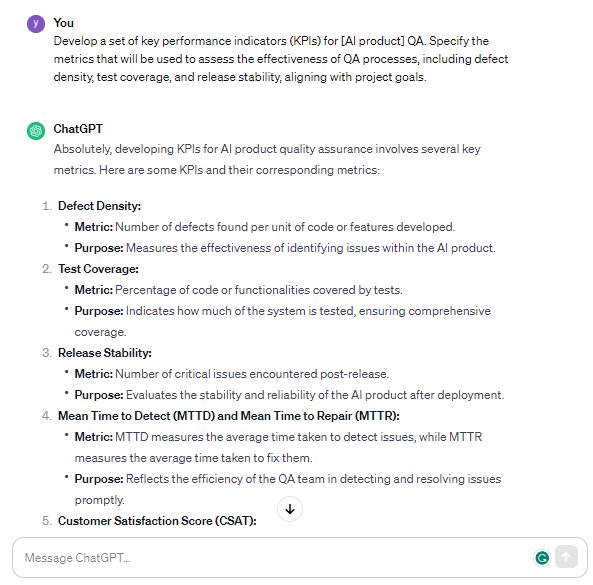
2. Test Execution and Progress Metrics:
Outline the metrics used to measure test execution and progress. Specify how metrics such as test case execution rates, test completion status, and progress against testing timelines will be monitored to ensure timely and effective testing.
3. Defect Life Cycle Metrics:
Define metrics related to the defect life cycle in [project or product] QA. Specify how metrics such as defect detection rate, time to fix defects, and the effectiveness of root cause analysis will be used to continuously improve defect management processes.
4. Automation Test Coverage Metrics:
Develop metrics for assessing automation test coverage. Specify how metrics will be used to evaluate the percentage of test cases automated, the coverage of critical paths, and the impact of automation on overall testing efficiency.
5. Metrics for Code Quality:
Establish metrics for evaluating code quality from a testing perspective. Specify how metrics such as code coverage, code review findings related to testability, and the correlation between code changes and test case updates will be used to ensure high-quality code.
6. Customer Satisfaction Measurement:
Define approaches for measuring customer satisfaction related to [product or service] quality. Specify the metrics used to collect and analyze user feedback, customer-reported issues, and overall satisfaction levels, guiding QA improvements.
7. Time-to-Market Metrics:
Develop metrics for measuring time-to-market efficiency in [project or product] QA. Specify how metrics such as release cycles, time taken for testing phases, and overall time efficiency will be monitored to support timely product deliveries.
8. Efficiency of Regression Testing Metrics:
Outline metrics for evaluating the efficiency of regression testing. Specify how metrics like regression test suite execution time, the percentage of automated regression tests, and the impact on release velocity will be measured and optimized.
9. Metrics for Test Environment Stability:
Define metrics for assessing the stability of the test environment. Specify how metrics such as environment downtime, resource availability, and the impact of environmental issues on testing outcomes will be monitored and addressed.
10. Adherence to QA Processes Metrics:
Establish metrics for evaluating the adherence to QA processes. Specify how metrics related to process compliance, the completion of required documentation, and the effectiveness of process audits will be measured to maintain consistency in QA practices.
Visit: 61 Easy And Well-Defined Google Bard Prompts For Business Plans
11. Risk Management
1. Risk Identification Strategies:
Develop strategies for identifying risks within [project or product] QA. Specify how the QA team will proactively identify potential risks, involving team members, stakeholders, and utilizing historical data to compile a comprehensive risk register.
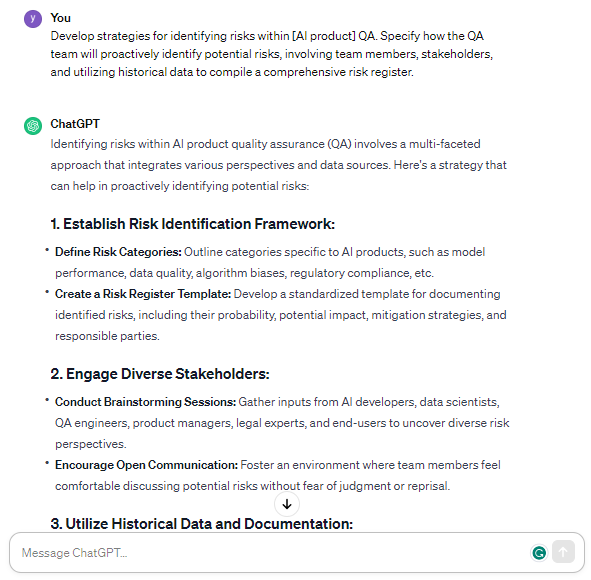
2. Quantitative and Qualitative Risk Assessment:
Outline the approach for both quantitative and qualitative risk assessments in [project or product] QA. Specify how risks will be assessed based on probability and impact, and describe the criteria for categorizing risks as low, medium, or high priority.
3. Risk Mitigation Planning:
Develop detailed plans for mitigating identified risks. Specify how mitigation strategies will be developed, assigned to responsible parties, and integrated into the project plan to minimize the impact of potential issues.
4. Contingency Planning for High-Risk Scenarios:
Establish contingency plans for high-risk scenarios in [project or product] QA. Specify how the team will develop specific plans for addressing critical risks, including predefined actions, communication strategies, and resource allocations to manage unforeseen challenges.
5. Risk Monitoring and Control Measures:
Define monitoring and control measures for ongoing risk management. Specify how risks will be continually monitored, including the use of key performance indicators (KPIs), and describe the triggers for implementing predefined risk response plans.
6. Integration of Risk Management into QA Processes:
Integrate risk management seamlessly into QA processes. Specify how risk assessments and mitigation plans will be embedded into testing and validation activities, ensuring that risk considerations are part of everyday QA decision-making.
7. Communication of Risk Information:
Outline a communication plan for disseminating risk information within the QA team and to relevant stakeholders. Specify how risk updates, changes in risk status, and mitigation efforts will be communicated regularly to maintain transparency and awareness.
8. Impact Assessment on QA Deliverables:
Assess the potential impact of identified risks on QA deliverables. Specify how risks will be evaluated in terms of their effects on test plans, test cases, and overall testing schedules, and describe the strategies for maintaining QA quality in the face of uncertainties.
9. Risk Documentation and Reporting:
Develop comprehensive documentation and reporting mechanisms for risks in [project or product] QA. Specify how the risk register, risk logs, and risk reports will be maintained, and describe the frequency and format of risk reporting to project stakeholders.
10. Continuous Improvement in Risk Management Processes:
Establish a framework for continuous improvement in risk management processes. Specify how lessons learned from past projects will be incorporated, and describe mechanisms for refining risk identification, assessment, and mitigation strategies for future QA endeavors.
Visit: 301 Tested Bing AI Prompts For Business
12. Communication
1. Stakeholder Communication Plan:
Develop a stakeholder communication plan for [project or product] QA. Specify the key stakeholders, their communication preferences, and the frequency and format of communication to ensure transparent and effective information dissemination.
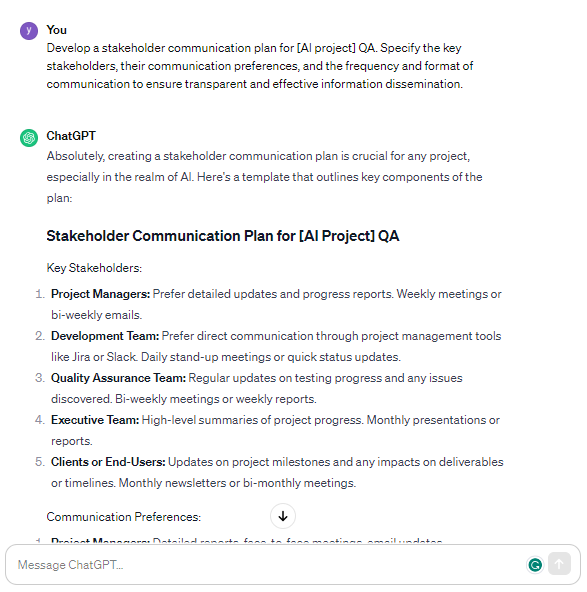
2. Cross-Team Collaboration Strategies:
Outline strategies for fostering cross-team collaboration within [project or product] QA. Specify how communication channels will be established, collaboration tools utilized, and regular meetings organized to facilitate effective communication between QA, development, and other teams.
3. Status Reporting for QA Activities:
Design a comprehensive status reporting mechanism for QA activities. Specify how status reports will be generated, what key metrics will be included, and the frequency at which updates will be shared to keep all stakeholders informed about QA progress.
4. Effective Meeting Management:
Establish guidelines for effective meeting management within the QA team. Specify how meeting agendas will be structured, participation encouraged, and action items documented to ensure that meetings contribute to clear communication and decision-making.
5. Transparent Defect Reporting Procedures:
Develop transparent procedures for defect reporting within [project or product] QA. Specify how defects will be documented, categorized, and communicated to development teams, including the use of defect tracking tools and regular defect triage meetings.
6. Change Management Communication:
Define a communication strategy for change management within QA processes. Specify how changes to testing requirements, methodologies, or schedules will be communicated, and describe the mechanisms for obtaining feedback and addressing concerns from the QA team.
7. Effective Communication in Remote Teams:
Address the nuances of effective communication in remote QA teams. Specify how virtual communication tools will be utilized, the importance of clear documentation, and strategies for overcoming challenges associated with remote collaboration.
8. Feedback Channels for Continuous Improvement:
Establish feedback channels for continuous improvement in communication practices. Specify how team members will provide feedback on communication processes, and describe how this feedback will be analyzed and incorporated into communication improvements.
9. Escalation Protocols:
Develop clear escalation protocols for [project or product] QA. Specify how issues or challenges that require higher-level attention will be escalated, the criteria for escalation, and the communication paths to ensure timely resolution.
10. Knowledge Sharing Platforms:
Implement knowledge-sharing platforms within the QA team. Specify how knowledge repositories, wikis, or collaboration tools will be used to facilitate information sharing, fostering a culture of open communication and collaborative learning among team members.
Visit: 500+ Hand-Crafted Bing AI Prompts For Investors
11. Communication During Critical Incidents:
Develop communication strategies for addressing critical incidents within [project or product] QA. Specify how incidents affecting quality will be communicated to relevant stakeholders, the frequency of updates during incidents, and the process for post-incident communication and analysis.
12. Training Communication for QA Team:
Outline communication plans for training initiatives within the QA team. Specify how information about training programs, schedules, and resources will be communicated to team members, and describe the mechanisms for gathering feedback on training effectiveness.
13. Collaboration with External QA Teams:
Define communication protocols when collaborating with external QA teams or vendors. Specify how information will be shared, meetings organized, and updates communicated to ensure seamless integration and coordination between internal and external QA efforts.
14. Customer-Facing Communication Procedures:
Establish procedures for customer-facing communication related to QA activities. Specify how information about quality assurance processes, updates on defect resolutions, and any impact on user experience will be communicated to end-users or clients.
15. Documentation Communication Standards:
Define communication standards for QA documentation. Specify how documentation, including test plans, test cases, and quality reports, will be communicated within the team, and describe the versioning and accessibility protocols for these documents.
Visit: 157 Best Google Bard Prompts For Digital Marketing
16. Communication During Release Planning:
Develop a communication plan for release planning within [project or product] QA. Specify how release timelines, testing schedules, and any changes to the release plan will be communicated to stakeholders, ensuring alignment and awareness throughout the release cycle.
17. Performance Review Feedback Communication:
Outline strategies for communicating performance review feedback within the QA team. Specify how constructive feedback will be delivered, opportunities for improvement discussed, and the overall performance review process communicated transparently to team members.
18. Alignment of Communication with Agile Practices:
Align communication practices with Agile methodologies within [project or product] QA. Specify how daily stand-ups, sprint reviews, and retrospectives will be utilized to enhance communication, collaboration, and continuous improvement in an Agile context.
19. Communication on Tooling and Technology Updates:
Develop communication plans for updates to testing tools and technologies within the QA team. Specify how information on new tools, upgrades, or changes in technology stack will be communicated, and describe training opportunities provided to ensure a smooth transition.
20. Celebrating QA Achievements:
Define ways to celebrate and communicate QA achievements. Specify how successful QA initiatives, milestones, and contributions to project success will be acknowledged and communicated, fostering a positive and motivating work environment.
Visit: 600+ Well-Structured Bing Chat Prompts For Marketing
21. Communication Strategies for Process Changes:
Develop communication strategies for introducing changes to QA processes within [project or product]. Specify how changes will be communicated to the team, including the rationale behind them, and describe the mechanisms for addressing concerns and gathering feedback during the transition.
22. Communication of Test Environment Updates:
Outline communication plans for updates to the test environment in [project or product] QA. Specify how changes to the test environment, including configurations and data setups, will be communicated to the testing team to ensure awareness and preparedness.
23. Communication during Team Onboarding:
Define communication practices for onboarding new members into the QA team. Specify how information about team roles, responsibilities, processes, and expectations will be effectively communicated to new team members, fostering a smooth integration process.
24. Communication of Testing Strategy:
Develop a comprehensive communication plan for sharing the testing strategy within the QA team and with other stakeholders. Specify how the testing strategy document will be disseminated, and describe mechanisms for addressing questions and clarifying key points.
25. Feedback Collection during Sprint Retrospectives:
Establish communication channels for collecting feedback during sprint retrospectives in Agile QA. Specify how team members will provide feedback on sprint performance, communication effectiveness, and areas for improvement, contributing to iterative enhancements.
26. Communication of QA Resource Allocation:
Outline communication practices for resource allocation within [project or product] QA. Specify how resource assignments, including test environments, tools, and team members, will be communicated to ensure clarity and coordination throughout the testing process.
27. Communication of Compliance Requirements:
Develop communication strategies for ensuring compliance with industry standards and regulatory requirements within [project or product] QA. Specify how updates to compliance standards will be communicated, and describe processes for adapting QA practices to meet evolving compliance needs.
28. Communication during Knowledge Transfer Sessions:
Define communication approaches for knowledge transfer sessions within the QA team. Specify how knowledge-sharing sessions, including lessons learned and best practices, will be communicated to ensure continuous learning and improvement.
29. Communication of Test Data Management Procedures:
Develop communication plans for test data management procedures within [project or product] QA. Specify how test data generation, masking, and management processes will be communicated, and describe the mechanisms for ensuring data privacy and security compliance.
30. Communication of QA Roadmaps:
Outline communication strategies for sharing QA roadmaps with stakeholders. Specify how QA roadmaps, outlining future testing initiatives, improvements, and milestones, will be communicated to align stakeholder expectations and demonstrate the strategic vision of QA within the project.
Visit: 99 Best Google Bard Prompts For Email Strategy
13. Compliance and Certification
1. Establishing Compliance Frameworks:
Develop a framework for ensuring compliance within [project or product] QA. Specify how relevant regulatory requirements, industry standards, and internal policies will be identified, and describe the procedures for aligning QA processes with these compliance frameworks.
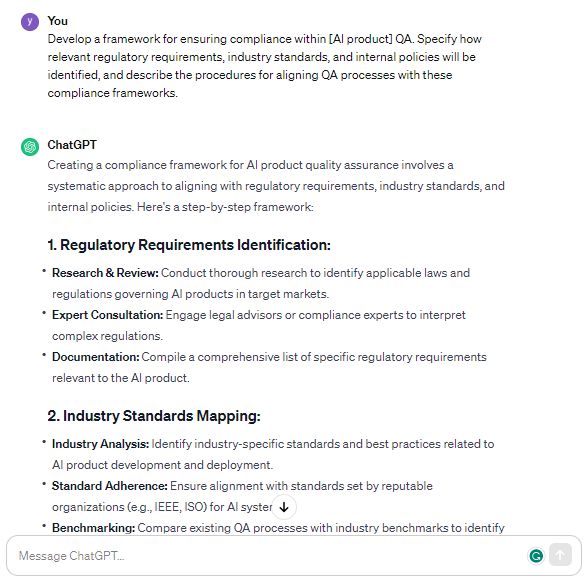
2. Compliance Assessment Strategies:
Outline strategies for conducting compliance assessments within [project or product] QA. Specify how compliance checks will be carried out, the criteria for evaluating adherence to standards, and the frequency of assessments to ensure ongoing compliance.
3. Documentation for Regulatory Requirements:
Define documentation practices for meeting regulatory requirements within QA processes. Specify how documentation will be organized, updated, and maintained to demonstrate compliance with specific regulations, standards, and certification criteria.
4. Certification Preparation Plans:
Develop comprehensive plans for preparing for certifications within [project or product] QA. Specify the certification criteria, the steps involved in preparing for certification audits, and the timeline for achieving and maintaining certification status.
5. Communication of Compliance Expectations:
Establish communication practices for conveying compliance expectations within the QA team. Specify how team members will be informed about relevant regulations, standards, and certification requirements, and describe mechanisms for addressing compliance-related queries.
6. Integration of Security Standards:
Outline the integration of security standards into QA processes. Specify how security requirements will be identified, incorporated into testing scenarios, and validated to ensure that [project or product] meets security compliance standards.
7. Audit Preparedness Strategies:
Develop strategies for ensuring continuous audit preparedness within [project or product] QA. Specify how the QA team will be ready for external audits, the documentation required, and the procedures for addressing audit findings and implementing corrective actions.
8. Continuous Monitoring for Compliance:
Define approaches for continuous monitoring of compliance within QA processes. Specify how compliance metrics will be tracked, key performance indicators (KPIs) monitored, and the mechanisms for real-time identification and correction of compliance deviations.
9. Certification Renewal Processes:
Establish processes for the renewal of certifications within [project or product] QA. Specify the timelines and steps involved in certification renewal, including the review of ongoing compliance, documentation updates, and preparation for recertification audits.
10. Training on Compliance Requirements:
Develop a training program for QA team members on compliance requirements. Specify how training sessions will be conducted, the content covered, and the frequency of training to ensure that team members are well-versed in compliance expectations.
Visit: 200+ Best Google Bard Prompts For Investors
14. Customer Satisfaction
1. Developing a Customer Satisfaction Measurement Framework:
Develop a comprehensive framework for measuring customer satisfaction within [project or product] QA. Specify the key performance indicators (KPIs) and metrics that will be used, the methods for collecting customer feedback, and the frequency of satisfaction assessments to ensure ongoing improvement.
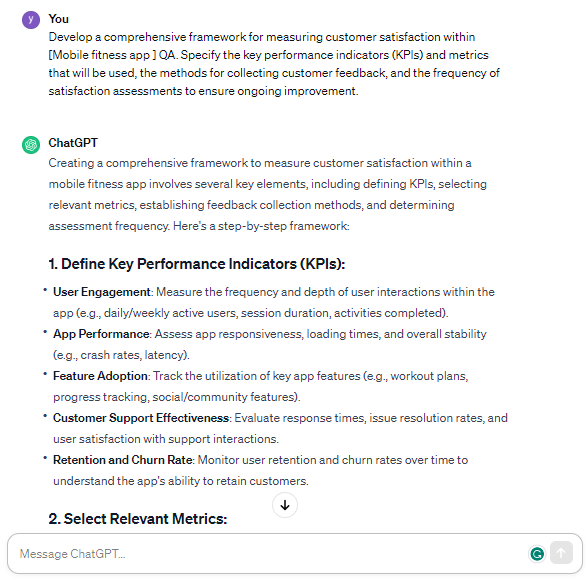
2. Defining Customer-Focused QA Objectives:
Define QA objectives that are directly aligned with customer satisfaction goals. Specify how QA processes and activities will be designed to enhance the end-user experience, and describe key performance indicators that reflect the impact of QA on customer satisfaction.
3. Customer Feedback Integration into QA Processes:
Outline strategies for integrating customer feedback into [project or product] QA processes. Specify how customer feedback will be systematically collected, analyzed, and used to influence testing priorities, defect resolutions, and overall QA strategies.
4. Establishing Clear Communication Channels with Customers:
Establish clear communication channels with customers regarding QA activities. Specify how updates on testing progress, release schedules, and quality improvements will be communicated to customers, fostering transparency and keeping them informed.
5. Customer-Centric Defect Resolution Procedures:
Develop procedures for customer-centric defect resolution within [project or product] QA. Specify how customer-reported issues will be prioritized, resolved, and communicated back to customers, ensuring a responsive and customer-focused approach to quality assurance.
6. Proactive Communication of Quality Assurance Initiatives:
Proactively communicate QA initiatives to customers. Specify how information about improvements in testing processes, adoption of new technologies, and overall QA strategies will be shared to demonstrate the commitment to delivering a high-quality product or service.
7. Customer Involvement in User Acceptance Testing (UAT):
Outline strategies for involving customers in User Acceptance Testing (UAT). Specify how customers will be engaged in testing activities, the criteria for selecting UAT participants, and the mechanisms for capturing valuable user insights during testing.
8. Post-Release Customer Surveys:
Implement post-release customer satisfaction surveys within [project or product] QA. Specify how surveys will be designed, distributed, and analyzed to gather feedback on the released product or service, and describe how the results will inform future QA efforts.
9. Feedback-Driven Continuous Improvement:
Develop a culture of continuous improvement based on customer feedback within the QA team. Specify how feedback loops will be established, the mechanisms for analyzing feedback trends, and the strategies for implementing changes that positively impact customer satisfaction.
10. Customer Education on QA Processes:
Develop educational materials for customers on QA processes. Specify how customers will be informed about the testing methodologies, quality assurance practices, and the value QA brings to ensuring a reliable and high-performing product or service.
Visit: 55 Helpful Google Bard Prompts For Finance
11. Implementing a Customer Support Integration Plan:
Develop a plan for integrating QA processes with customer support efforts. Specify how QA data, such as defect trends and common issues, will be shared with customer support teams to enhance their ability to address customer inquiries and issues effectively.
12. Customer-Centric Test Case Design:
Design test cases with a customer-centric focus within [project or product] QA. Specify how test scenarios will be aligned with user expectations, preferences, and real-world usage patterns, ensuring that QA efforts directly contribute to a positive end-user experience.
13. Surveys for Gathering Feature Priorities:
Implement surveys to gather customer opinions on feature priorities within [project or product] QA. Specify how surveys will be designed to assess customer preferences, expectations, and priorities, and describe how the results will influence feature development and QA planning.
14. Customer-Focused Usability Testing:
Outline strategies for customer-focused usability testing. Specify how usability tests will incorporate real users, their feedback, and overall user experience considerations, ensuring that the product or service aligns closely with customer expectations.
15. Establishing a Customer Advocacy Program:
Develop a customer advocacy program within the QA framework. Specify how satisfied customers can become advocates, providing testimonials, participating in case studies, and contributing to the promotion of QA practices as a value-added aspect of the overall product or service.
Visit: 67 Powerful Google Bard Prompts For Store Audit
16. Customer Communication during Release Rollouts:
Define communication strategies for customers during release rollouts within [project or product] QA. Specify how customers will be informed about new features, enhancements, and any potential impacts on their usage, ensuring a smooth transition and minimizing disruptions.
17. Customer Satisfaction Metrics for QA Teams:
Establish metrics for measuring customer satisfaction specific to QA teams. Specify how the effectiveness of QA activities in positively impacting customer satisfaction will be quantified, allowing for continuous monitoring and improvement.
18. Social Media Monitoring for Customer Feedback:
Incorporate social media monitoring into the QA process for gathering customer feedback. Specify how social media channels will be monitored for discussions, feedback, and sentiments related to the product or service, contributing to a proactive and responsive QA approach.
19. Customer-Centric Test Environments:
Design test environments that mimic real-world customer scenarios. Specify how test environments will be representative of diverse user conditions and scenarios, ensuring that QA activities comprehensively address the varied needs and experiences of customers.
20. Customer-Focused Release Notes:
Develop customer-focused release notes within [project or product] QA. Specify how release notes will be crafted to communicate changes, improvements, and fixes in a language that resonates with customers, enhancing transparency and understanding of the QA efforts.
Visit: Unlock Success With These 67 Google Bard Prompts For Trading
21. Implementing Customer-Centric Regression Testing:
Develop strategies for customer-centric regression testing within [project or product] QA. Specify how regression testing will prioritize critical customer journeys, ensuring that updates and changes do not negatively impact key aspects of the user experience.
22. Customer Involvement in Beta Testing:
Outline plans for involving customers in beta testing phases. Specify how customers will be recruited, the level of engagement expected, and the mechanisms for collecting valuable insights and feedback during beta testing to refine QA processes.
23. Customer-Focused Accessibility Testing:
Design accessibility testing with a focus on customer needs. Specify how accessibility requirements will be incorporated into QA processes, ensuring that [project or product] is inclusive and user-friendly for customers with diverse abilities.
24. Customer Feedback-Driven Test Case Updates:
Develop a process for updating test cases based on customer feedback. Specify how insights from customer-reported issues will be used to refine and expand test cases, contributing to a more robust QA strategy aligned with customer expectations.
25. Establishing a Customer Advisory Board:
Create a customer advisory board within the QA framework. Specify how customers will be invited to participate, the structure of advisory board meetings, and how their feedback will be actively sought to shape QA priorities and strategies.
26. Customer-Centric Performance Testing:
Design performance testing scenarios that reflect real-world customer usage patterns. Specify how performance testing will simulate varying user loads, geographic locations, and network conditions, ensuring [project or product] performs optimally under diverse customer scenarios.
27. Customer Satisfaction Surveys after Support Interactions:
Implement customer satisfaction surveys after support interactions. Specify how surveys will be triggered, the specific questions asked, and how the feedback received will be analyzed to enhance both customer support and QA processes.
28. Customer-Centric Training Programs:
Develop training programs for the QA team with a customer-centric focus. Specify how training modules will emphasize understanding customer needs, expectations, and behaviors, fostering a customer-oriented mindset among QA team members.
29. Customer Feedback Integration into QA Metrics:
Outline strategies for integrating customer feedback into QA performance metrics. Specify how customer satisfaction scores, feedback trends, and other customer-centric metrics will be incorporated into overall QA KPIs to provide a holistic view of QA effectiveness.
30. Customer-Centric Test Automation Strategies:
Develop test automation strategies with a focus on customer-centric scenarios. Specify how automated tests will cover critical customer journeys, and describe the criteria for selecting test cases that align with customer expectations and preferences.
Visit: 55 Magnificent Google Bard Prompts For Product Management
15. Documentation and Reporting
1. Creating Comprehensive Test Plans:
Develop a strategy for creating comprehensive test plans within [project or product] QA. Specify how test plans will be structured, the key elements to include, and the criteria for ensuring that test plans effectively guide testing efforts and align with project objectives.
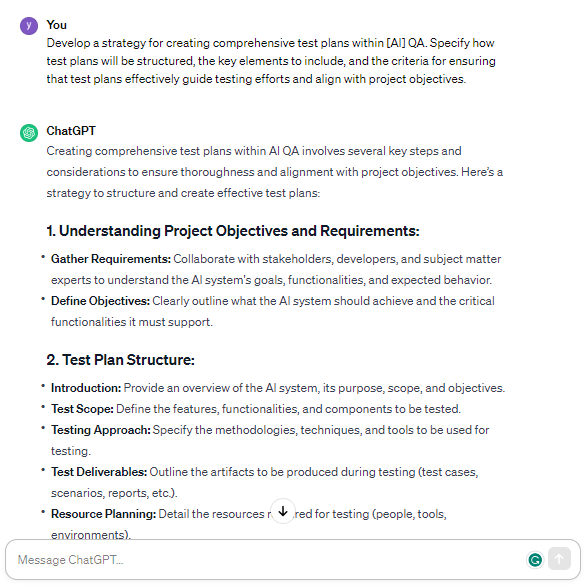
2. Documentation Standards for Test Cases:
Establish documentation standards for test cases within [project or product] QA. Specify how test cases will be written, organized, and updated, ensuring clarity, traceability, and ease of execution for both manual and automated testing processes.
3. Test Execution Reporting Strategies:
Outline strategies for reporting test execution results within [project or product] QA. Specify how test execution reports will be generated, the level of detail to include, and the frequency of reporting to keep stakeholders informed about the progress of testing activities.
4. Defect Logging and Reporting Procedures:
Develop procedures for logging and reporting defects within [project or product] QA. Specify how defects will be documented, categorized, and communicated to development teams, including the use of defect tracking tools and regular defect triage meetings.
5. Traceability Matrix Implementation:
Implement a traceability matrix within [project or product] QA. Specify how the matrix will link requirements to test cases, ensuring comprehensive test coverage, and describe how traceability will be maintained and reported throughout the testing lifecycle.
6. Quality Metrics Dashboard Design:
Design a quality metrics dashboard for [project or product] QA. Specify the key performance indicators (KPIs) and metrics to include, the visualization techniques to be used, and how the dashboard will provide a quick and insightful overview of QA effectiveness.
7. Progress Reporting for Agile QA:
Develop strategies for progress reporting in an Agile QA environment. Specify how progress will be communicated during daily stand-ups, sprint reviews, and retrospectives, ensuring that stakeholders are consistently informed about the status of testing activities.
8. Test Environment Configuration Documentation:
Establish documentation practices for test environment configurations within [project or product] QA. Specify how test environment configurations will be documented, versioned, and communicated to the testing team, ensuring consistent and reliable testing environments.
9. Documentation for Release Readiness:
Develop documentation to assess release readiness within [project or product] QA. Specify the criteria for determining when a release is ready, the documentation required, and the communication protocols to inform stakeholders about the readiness status.
10. Continuous Improvement Documentation Framework:
Design a framework for documenting continuous improvement initiatives within the QA team. Specify how lessons learned, feedback, and improvement actions will be documented, contributing to a knowledge base that informs future QA processes and decisions.
Visit: 67 Useful Google Bard Prompts For Cross-Selling
16. Closure and Evaluation
1. Post-Release Evaluation Procedures:
Develop procedures for post-release evaluation within [project or product] QA. Specify how post-release metrics, user feedback, and performance data will be collected and analyzed to assess the overall quality of the release and inform future QA strategies.
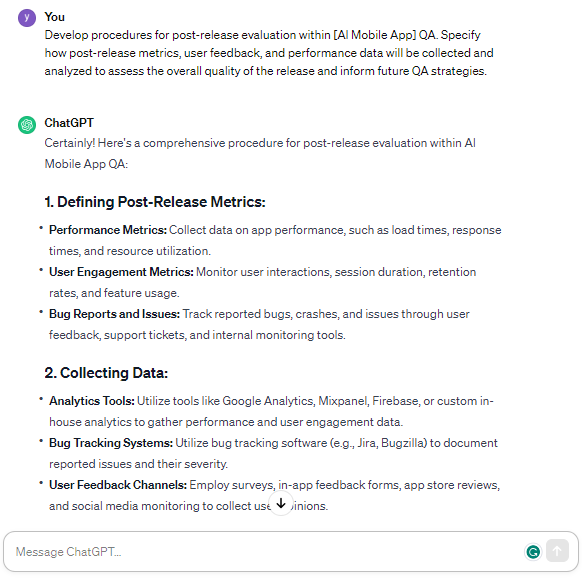
2. Closure Criteria for Test Phases:
Establish closure criteria for different test phases within [project or product] QA. Specify the criteria that must be met before closing unit testing, integration testing, system testing, and other phases, ensuring thorough and systematic testing throughout the development lifecycle.
3. Post-Mortem Analysis for QA Processes:
Implement a post-mortem analysis process for QA processes within [project or product] QA. Specify how post-mortem meetings will be conducted, what aspects of QA processes will be evaluated, and the steps taken to address challenges and implement improvements for future projects.
4. Closure Documentation for QA Activities:
Develop documentation practices for closure of QA activities within [project or product] QA. Specify how closure reports will be generated, what information they will include, and the mechanisms for archiving and organizing closure documentation for future reference.
5. Stakeholder Feedback Collection:
Outline strategies for collecting stakeholder feedback at the closure of QA activities. Specify how feedback will be gathered from project managers, developers, and other stakeholders, and describe the mechanisms for addressing concerns and incorporating feedback into QA processes.
Visit: 61 Awesome Google Bard Prompts For Better User Experience
6. Customer Satisfaction Evaluation Post-Release:
Develop a process for evaluating customer satisfaction post-release within [project or product] QA. Specify how customer satisfaction metrics will be collected, the methods for gathering customer feedback, and how the results will be analyzed to inform future QA strategies.
7. Lessons Learned Documentation Framework:
Design a framework for documenting lessons learned within the QA team. Specify how lessons learned from [project or product] QA activities will be documented, shared, and incorporated into future QA practices to foster continuous improvement.
8. Evaluation of Test Coverage:
Implement strategies for evaluating test coverage within [project or product] QA. Specify how test coverage reports will be generated, what criteria define comprehensive test coverage, and how gaps in coverage will be identified and addressed for future testing cycles.
9. Analysis of Defect Life Cycle:
Conduct an analysis of the defect life cycle within [project or product] QA. Specify how defect data will be analyzed, including detection rates, resolution times, and root cause analysis, and describe the strategies for improving defect management processes in subsequent projects.
10. Performance Evaluation of QA Team:
Develop a performance evaluation process for the QA team within [project or product] QA. Specify the key performance indicators (KPIs) for assessing QA team performance, the frequency of evaluations, and how the results will be used to recognize achievements and identify areas for growth.
Visit: 67 Effective Google Bard Prompts for Upselling Success
11. Documentation Review and Archiving Procedures:
Establish procedures for reviewing and archiving QA documentation within [project or product] QA. Specify how documentation will be systematically reviewed for completeness and accuracy, and describe the archiving process to ensure that valuable information is preserved for future reference.
12. Vendor and Third-Party Evaluation Protocols:
Develop evaluation protocols for vendor and third-party contributions within [project or product] QA. Specify how the quality of deliverables from external partners will be assessed, the criteria for acceptance, and the mechanisms for providing constructive feedback to enhance collaboration.
13. Customer Impact Assessment Post-Release:
Implement procedures for assessing customer impact post-release within [project or product] QA. Specify how the impact of the release on end-users will be evaluated, the methods for identifying potential issues, and the strategies for mitigating any adverse effects on customers.
14. Closure Criteria for QA Projects:
Establish closure criteria for entire QA projects within [project or product] QA. Specify the conditions that must be met before officially closing a QA project, including the completion of all test phases, resolution of critical defects, and satisfaction of acceptance criteria.
15. Evaluation of Testing Tools and Technologies:
Conduct an evaluation of testing tools and technologies used within [project or product] QA. Specify how the effectiveness of tools will be assessed, the criteria for selecting or retiring tools, and the process for keeping testing toolsets up-to-date and aligned with project requirements.
16. Post-Release Performance Monitoring:
Develop a plan for post-release performance monitoring within [project or product] QA. Specify how the performance of the released product or service will be continuously monitored, including the use of performance metrics and proactive measures to address any degradation over time.
17. Cross-Functional Collaboration Assessment:
Implement an assessment of cross-functional collaboration within [project or product] QA. Specify how collaboration among development, QA, and other teams will be evaluated, the criteria for success, and the strategies for improving cross-functional communication and cooperation.
18. Evaluation of Test Data Management Practices:
Conduct an evaluation of test data management practices within [project or product] QA. Specify how test data generation, masking, and management processes will be assessed, and describe the strategies for enhancing data privacy, security, and relevance in future testing efforts.
19. Continuous Improvement Feedback Loops:
Design feedback loops for continuous improvement within [project or product] QA. Specify how feedback from team members, stakeholders, and customers will be systematically collected, analyzed, and used to drive ongoing improvements in QA processes and methodologies.
20. Evaluation of QA Training Programs:
Evaluate the effectiveness of QA training programs within the QA team. Specify how training programs will be assessed for their impact on team skills and performance, and describe the strategies for refining training content and methodologies based on the evaluation results.
Visit: 57 Proven Google Bard Prompts For Customer Retention
Visit Our Free AI tools
Prompts AI Hub Team Has Tailored Their AI Knowledge and Created Tools for You Free of Cost, Enjoy
Final Thoughts:
In conclusion, these 315 meticulously crafted ChatGPT prompts for Quality Assurance (QA) serve as a powerhouse of guidance for elevating your testing strategies. Seamlessly integrate these prompts into your QA arsenal to bolster efficiency and precision. Stay ahead in the QA game by leveraging these invaluable resources for a robust and effective quality assurance process.
Download All Prompts
To Download 50K Plus Prompts Click Below and Get Them In One Click.
Q1: Why is documentation crucial in the QA process, and how do these prompts address it?
Documentation is the backbone of QA, ensuring clarity and traceability. The provided prompts guide users in creating comprehensive test plans, defining documentation standards for test cases, and implementing closure documentation practices, fostering organized and well-documented QA activities.
Q2: How do the prompts contribute to continuous improvement in QA practices?
The prompts facilitate continuous improvement by emphasizing post-mortem analysis, lessons learned documentation, and feedback-driven loops. By implementing these strategies, users can analyze past projects, identify areas for improvement, and iteratively enhance their QA processes.
Q3: In what ways do the prompts prioritize customer satisfaction in QA?
The prompts offer insights into customer-centric testing, post-release customer surveys, and integration of customer feedback into QA processes. By incorporating these practices, QA professionals can actively prioritize end-user satisfaction, resulting in a higher quality product or service.
Q4: How does the article guide users in evaluating the effectiveness of testing tools and technologies?
The prompts guide users in evaluating testing tools and technologies by emphasizing their effectiveness in QA. This includes assessing tools, monitoring their impact on QA processes, and ensuring that the toolset aligns with project requirements.
Q5: Why should readers thoroughly explore and apply these prompts in their QA processes?
Thorough exploration and application of these prompts are essential for achieving excellence in QA. They provide practical insights, strategies for closure and evaluation, and a holistic approach to QA, empowering users to enhance their skills, streamline processes, and deliver high-quality results.
Q6: How can ChatGPT prompts enhance the quality assurance (QA) process?
ChatGPT prompts for QA provide detailed and comprehensive guidance across various QA aspects, offering valuable insights into documentation, closure, evaluation, customer satisfaction, and more. Leveraging these prompts ensures a streamlined and effective QA strategy.
Q7: How do the prompts address the importance of documentation in QA?
The prompts emphasize the significance of documentation in QA by guiding users on creating comprehensive test plans, defining documentation standards for test cases, and implementing closure documentation practices. This ensures clarity, traceability, and organized QA activities.
Q8: In what ways can the prompts contribute to continuous improvement in QA practices?
The prompts facilitate continuous improvement by encouraging post-mortem analysis, lessons learned documentation, and feedback-driven loops. By integrating these strategies, QA professionals can iteratively enhance their processes and deliver better results.
Q9: How do ChatGPT prompts prioritize customer satisfaction in QA?
The prompts offer insights into customer-centric testing, post-release customer surveys, and the integration of customer feedback into QA processes. Prioritizing end-user satisfaction is a key focus, ensuring QA efforts align with customer expectations.
Q10: Why should QA professionals consider thoroughly applying these ChatGPT prompts in their processes?
Thorough application of ChatGPT prompts in QA processes is essential for acquiring practical insights, strategies for closure and evaluation, and a holistic approach to QA. This empowers QA professionals to enhance their skills, streamline processes, and consistently deliver high-quality results.
For More Information, About Author Visit Our Team

